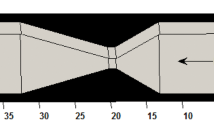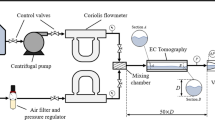Abstract
The performances of the venturi meters for oil–water flow under real oil well operating conditions were investigated in the present experimental investigation. The pressure drop measurements were studied in Tercom flanged machined venturi meters with a beta ratio (\(\beta )=0.4\), 0.5 and 0.6 for oil–water two-phase flow experiments in a 0.0762 m (3-in.) pipe. The experimental data for different fluid mixture flow rates and water cuts were acquired using a two-phase, large-scale inclinable flow loop. Potable water and Exxsol mineral oil (D80) were used for the single-phase and two-phase oil–water experiments for the three venturi meters. The experiments were conducted for water cuts varying from 0 to 100% in steps of 20%, flow rates ranging from 2000 to 10,000 barrels per day (bpd), and for horizontal and vertical flow loop inclinations (\(0{^{\circ }}\) and \(90{^{\circ }}\)). Real oil wells flow rates were matched by selecting test liquid flow rates. The experimental results showed that the venturi pressure drop varies as the square of the fluid flow rate for given water cut through the venturi meters studied. For given flow rate and water cut, the venturi pressure drop is inversely proportional to the venturi \(\beta \); however, the venturi pressure drop varies almost linearly with the water cut for a given fluid flow rate. Within the range of test fluid flow rates, the venturi pressure drop measurements were unaffected by the inclination of the three venturi meters studied in the flow loop. This is very important from an application standpoint.
Similar content being viewed by others
Abbreviations
- k :
-
Modified venturi discharge coefficient (\(\hbox {m}^{2}\) s/h)
- \(\beta \) :
-
Venturi beta ratio
- \({A}_{\mathrm{t}}\) :
-
Throat cross-sectional area (\(\hbox {m}^{2}\))
- \({A}_{\mathrm{p}}\) :
-
Pipe cross-sectional area (\({\mathrm{m}^{2}}\))
- D or \({D}_{\mathrm{h}}\) :
-
Hydraulic diameter (m)
- \({C}_{\mathrm{d}}\) :
-
Venturi discharge coefficient
- \(\hbox {Cp}_{\mathrm{m}}\) :
-
Mixture venturi pressure coefficient
- \(\lambda \) :
-
Water volume fraction or water cut
- \({Q}_{\mathrm{m}}\) :
-
Mixture flow rate (\(\hbox {m}^{3}/\hbox {h}\))
- \({Q}_{\mathrm{meas}}\) :
-
Measured fluid mixture flow rate (\(\hbox {m}^{3}/\hbox {h}\))
- \({Q}_{\mathrm{cal}}\) :
-
Calculated fluid mixture flow rate (\(\hbox {m}^{3}\)/h)
- \(\theta \) :
-
Inclination angle (degrees)
- \(V_{\mathrm{m}}\) :
-
Mixture average velocity at venturi inlet (m/s)
- \({Re}_{\mathrm{m}}\) :
-
Mixture Reynolds number
- \(\Delta {P}\) :
-
Venturi pressure drop (Pa)
- \(\upsilon _\mathrm{m}\) :
-
Mixture kinematic viscosity (m\(^{2}\)/s)
- \(\mu _\mathrm{m} \) :
-
Mixture dynamic viscosity (Pa s)
- \(\mu _\mathrm{w} \) :
-
Water dynamic viscosity (Pa s)
- \(\mu _\mathrm{o} \) :
-
Oil dynamic viscosity (Pa s)
- \(\rho _{\mathrm{m}}\) :
-
Fluid (or liquid) mixture density (\(\hbox {kg/m}^{3}\))
- o :
-
Oil
- w :
-
Water
- m :
-
Mixture
- t :
-
Venturi throat
- p :
-
Pipe
References
Gysling, D.L.; Corporation, C.: Wet gas metering using combination of differential pressure and SONAR flow meters. In: 24th International North Sea Flow Measurement Work, pp. 1–20 (2006)
Lide, F.; Tao, Z.; Ying, X.: Venturi wet gas flow modeling based on homogeneous and separated flow theory. In: Mathematical Problems in Engineering, vol. 2008 (2008)
Lide, F.; Tao, Z.: Performance of a horizontally mounted venturi in low pressure wet gas flow. Chin. J. Chem. Eng. 16(2), 320–324 (2008)
Li, X.; Huang, Z.; Meng, Z.; Wang, B.; Li, H.: Oil–water two-phase flow measurement using a venturi meter and an oval gear flow meter. Chem. Eng. Commun. 197(2), 223–231 (2009)
Silva, A.M.; Teixeira, J.C.F.; Teixeira, S.F.C.F.: Experiments in a large-scale venturi scrubber. Part I: pressure drop. Chem. Eng. Process. 48(1), 59–67 (2009)
Seraj, H.; Khaled, M.; Yusof, R.; Rahmat, M.F.: Review of wet gas flow measurement using venturi tubes and radio active materials. Int. J. Smart Sens. Intell. Syst 3(4), 672–689 (2010)
Hollingshead, C.L.; Johnson, M.C.; Barfuss, S.L.; Spall, R.E.: Discharge coefficient performance of venturi, standard concentric orifice plate, V-cone and wedge flow meters at low Reynolds numbers. J. Pet. Sci. Eng. 78, 559–566 (2011)
Abbas, A.W.Y.; Hasan, H.A.M.; Hadawey, A.; Waleed Abdul-Karem, K.F.A.-R.: Theoretical and experimental study of bubbly gas–water two phase flows through a universal venturi tube (UVT). Int. J. Inf. Sci. Educ. 2(1), 43–58 (2012)
Monni, G.; De Salve, M.; Panella, B.: Two-phase flow measurements at high void fraction by a venturi meter. Prog. Nucl. Energy 77, 167–175 (2014)
He, D.; Bai, B.: A new correlation for wet gas flow rate measurement with venturi meter based on two-phase mass flow coefficient. Measurement 58, 61–67 (2014)
Wang, W.; Liang, X.; Zhang, M.: Measurement of gas–liquid two-phase slug flow with a venturi meter based on blind source separation. Chin. J. Chem. Eng 23(9), 1447–1452 (2015)
Gajan, P.; Decaudin, Q.; Couput, J.P.: Analysis of high pressure tests on wet gas flow metering with a venturi meter. Flow Meas. Instrum. 44, 126–131 (2015)
Tan, C.; Dai, W.; Yeung, H.; Dong, F.: A Kalman estimation based oil–water two-phase flow measurement with CRCC. Int. J. Multiph. Flow 72, 306–317 (2015)
Yuan, C.; Xu, Y.; Zhang, T.; Li, J.; Wang, H.: Experimental investigation of wet gas over reading in venturi. Exp. Therm. Fluid Sci. 66, 63–71 (2015)
Bertoldi, D.; Dallalba, C.C.S.; Barbosa, J.R.: Experimental investigation of two-phase flashing flows of a binary mixture of infinite relative volatility in a venturi tube. Exp. Therm. Fluid Sci. 64, 152–163 (2015)
ExxonMobil Company, Typical Values of Dearomatized Fluid from www.exxonmobilchemical.com, Visited website in May 2014 (2014)
White, F.M.: Fluid Mechanics, 4th edn, p. 398. McGraw-Hill, New York (2001)
Acknowledgements
The authors gratefully wish to acknowledge the support provided by Saudi Aramco, Dhahran, Saudi Arabia, for funding this work through Project No. CER02386. Also the Center of Engineering Research (CER) at the Research Institute of King Fahd University of Petroleum and Minerals, Dhahran, Saudi Arabia, is acknowledged, for their technical support to complete this research work.
Author information
Authors and Affiliations
Corresponding author
Rights and permissions
About this article
Cite this article
Elobeid, M.O., Ahmad, A., Al-Sarkhi, A. et al. Pressure Drop Measurements in Venturi Meters of Different Beta Ratios for Oil–Water Flow Experiments. Arab J Sci Eng 43, 6355–6374 (2018). https://doi.org/10.1007/s13369-017-3019-8
Received:
Accepted:
Published:
Issue Date:
DOI: https://doi.org/10.1007/s13369-017-3019-8




